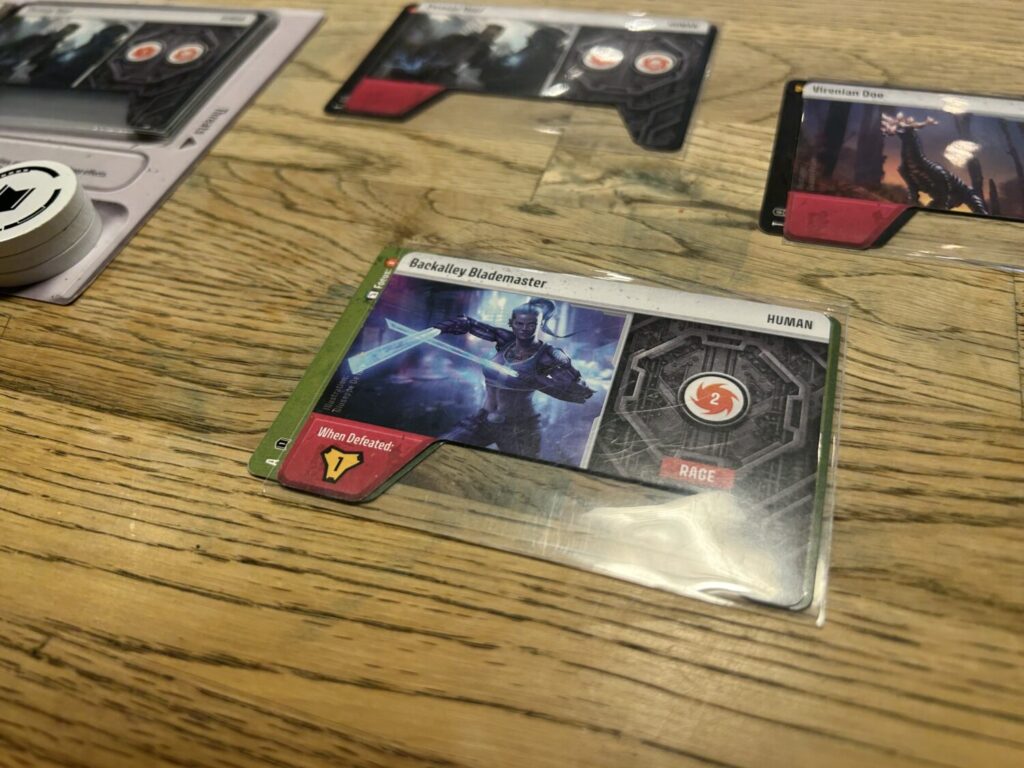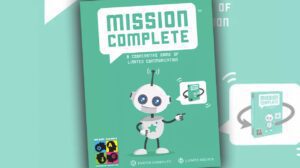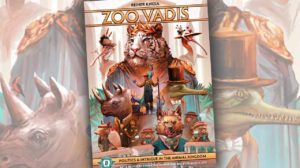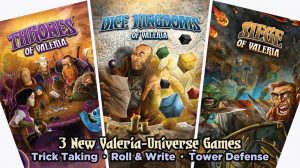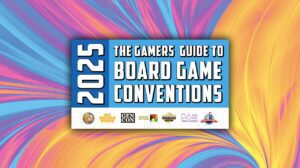Disclosure: Meeple Mountain received a free copy of this product in exchange for an honest, unbiased review. This review is not intended to be an endorsement.
You might assume that the title of Unstoppable, a fantastic solo deck builder from designer John D. Clair, is meant to describe your character. There’s evidence to support that theory. As the game progresses, as you blast through enemy after enemy and set off powerful, satisfying combos, you do come to feel prit-tee hard to stop. No one would fault you for assuming, when the title of a work is an adjective, that said adjective refers to the subject(s) of that work.
Bit of a twist here, folks: the title of the latest entry in Renegade’s Solo Hero series—which also includes the very good Warp’s Edge—isn’t about the hero at all. Extensive testing and research have laid bear the truth:
The “unstoppable” in Unstoppable refers to how hard it is to put this game down.

Card Play
It can’t be helped. Unstoppable operates on such a tight loop, plays so quickly, and seems to hinge on such narrow margins, that it’s impossible not to set it up for another try when you lose. This is, to borrow a phrase from a coworker, a dopamine machine, and I want to smash that button like an observant lab rat after sunset on Ramadan.
Like most co-op-style deck builders, the idea here is to play cards to crush your enemies. Some of your cards are Tactics, played once and then sent to the discard. Others are Allies, which stay out on the board to give you once-per-turn abilities. All of your abilities are ultimately focused on thrashing Threats—the baddies that litter the field—and, through cutting them down, laying waste to one of the three big baddies that come in the base box.
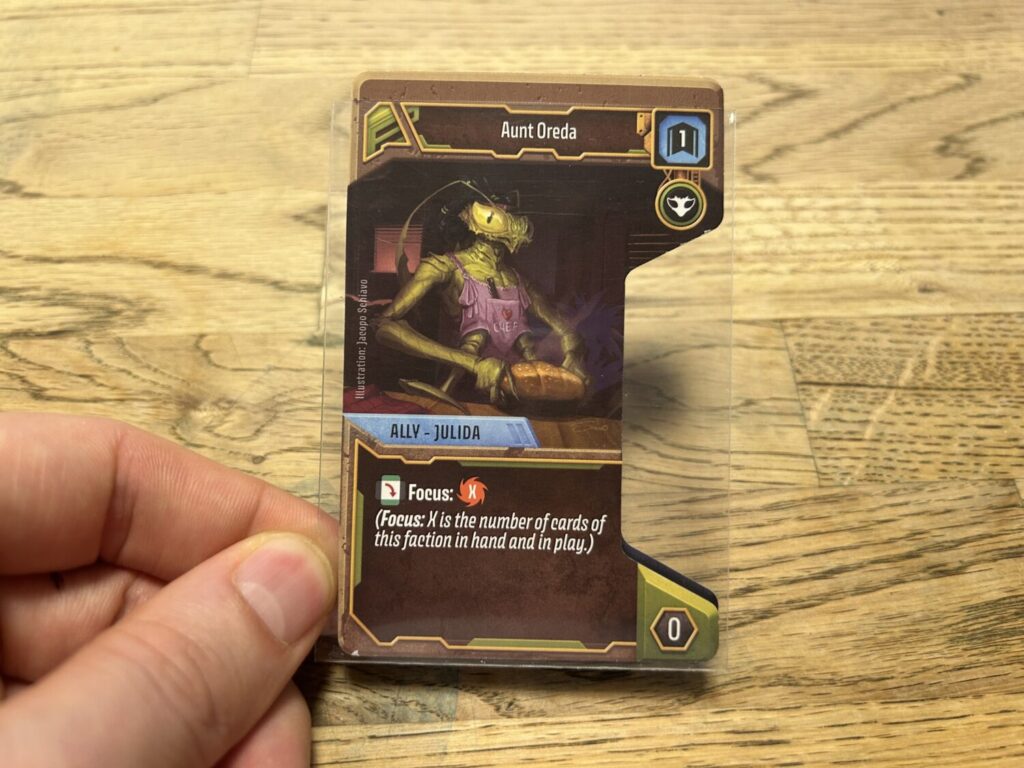
In most games of this ilk, like Aeon’s End or the less deck-buildy Arkham Horror: TCG, defeated bad guys go into a discard pile. Not so in Unstoppable. Every defeated Threat is turned over and added to your hand. How does that work? Every card in your deck is, in fact, two cards sleeved together, such that a Threat card is on one side and a player card is on the other. You may notice, as is evident in Exhibit A, that there is a strange notch on the right side of the card. We’ll return to that. For now, let the mystery ferment.
At the beginning of the game, the cards you reap will almost certainly be cheap little one-damage Tactics, but they could be one of your character’s more powerful starting cards, or any of the numerous cards you gain as you advance through the game. This is the first of the addictive properties baked into Unstoppable, that the defeat of every enemy doubles as opening a blind box.
The next layer of compulsion: constant improvement. At the beginning of every turn, no matter how well or how poorly you’re doing, you draw three cards from your current Level deck, one of six piles chock full of new and exciting cards, and pick one. Whichever card you choose gets sleeved with a new and unseen Threat before being added to your hand. This slow morphine drip, the addition of one new card every turn, is a big part of why Unstoppable is so addicting. Nary a turn goes by where you don’t add something to your hand, where you don’t get a new toy to play with. What’s more, every time you cycle through the entire deck, you level up, which means you get to start drawing cards from a better pile.
But even the most powerful cards sometimes aren’t enough. As the rounds of Unstoppable progress, the enemies get stronger. What was once a simple one-shot kill becomes, in short order, something much more serious, often outpacing the strength of your deck. That’s where the Upgrades come in.
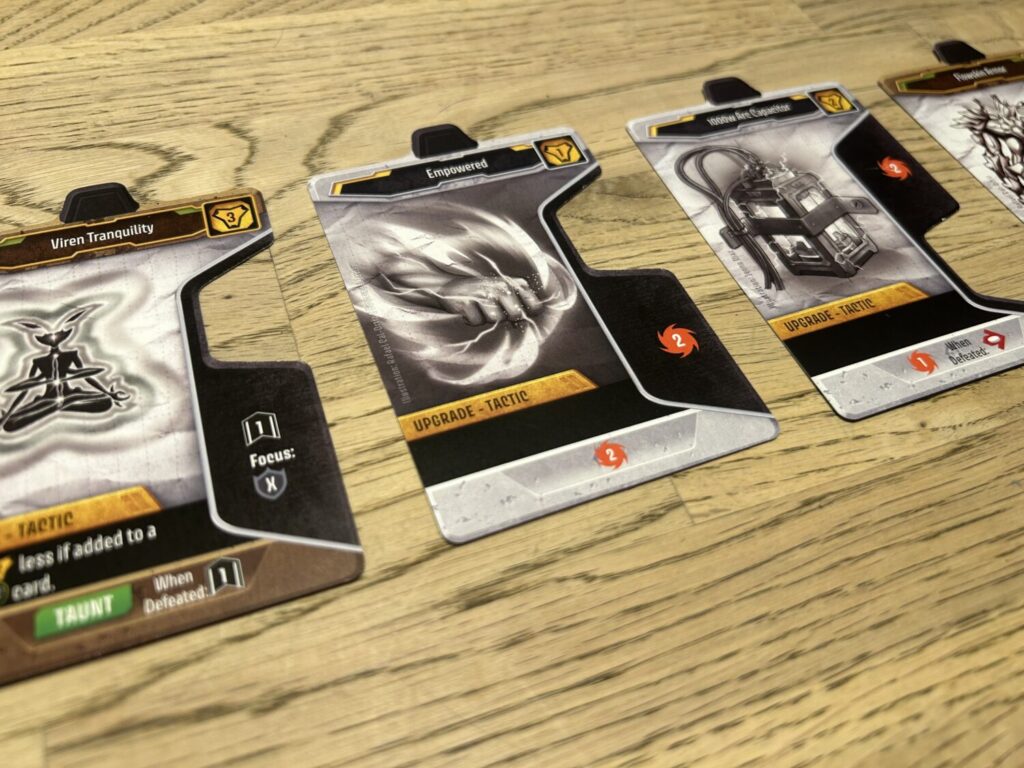
Upgrades
Remember that notch? That’s for the Upgrades. While you can’t buy cards to add to your hand, you can buy Upgrades to add to your cards. They get sleeved in between the Threat card and the player card, with whatever modifier they provide visible through that notch. Some Upgrades have an upper-slot modifier, while others have a lower-slot modifier. They can be combined, two per card, into absolute units.
It is tempting, and I should know, to spend your Credits on Upgrades right from the jump, but you won’t last long if you do that. “Better cards are better” is baked into the firmament of board gaming, a seemingly immutable law, but Unstoppable turns that on its ear. Better cards are indeed better, but Upgrades impact both sides of the card. Every Upgrade you add makes the Threat on the other side that much stronger. Beefing up one card until it deals four extra damage and gives you two extra action points seemed like a good idea at the time, but now that it’s a roided-up enemy with two extra defense and an extra attack, you may be less certain.
It turns out, after much trial and even more error, that Upgrades should be saved until those moments when you need them. This is the only part of the dopamine machine of Unstoppable that asks you to resist, to not give in, but that restraint adds to the game’s appeal. Boy does it feel good when you pull the lever.
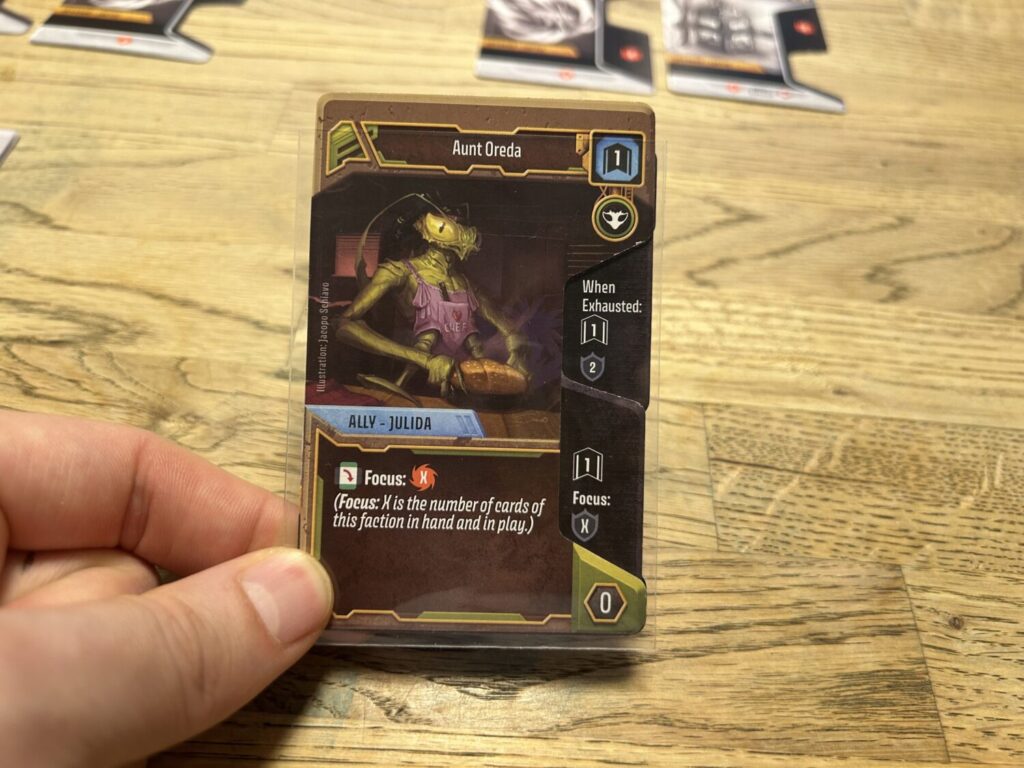
S-Y-N-E-R-G-Y
There are four Factions amongst the player cards, each of which emphasizes a different aspect of the game. The Council encourages inter-faction cooperation, with effects whose powers are commensurate to the number of different Factions you have both in play and in your hand. The Junkers give you money and make upgrades cheap. The Silver are all about dealing damage, often at your own expense. Then there are the Viren.
I love the Viren. They give me the strongest sense of story in what is otherwise a fairly mechanical enterprise. The Viren are praying mantis–like insectoids who work best as a swarm. Nearly every Viren card gets better with other Viren nearby. An Ally that starts the game dealing one damage per turn might, with the right combination of luck and planning, end up dealing eight or nine damage per turn by the end of the game.
Unstoppable’s approach to synergies is one of my favorite things about the design. Synergies are inherently fun. The realization that A or B pairs well with C or D is one of the joys of board games, but not everybody wants to take on the cognitive load of something like Magic, where every effect might modify anything else. “I would make two 1/1 tokens, but because I have this card in play and that card in play, and by casting this instant, I can instead play twenty-three 4/4 tokens, and they all have flying.” That’s a whole mess of business.
In Unstoppable, broadly speaking, card effects don’t modify other cards’ effects, but the Faction of each card, the suits that are present in my hand and in the play area, can impact the strength of other cards. That Viren does more damage because I have two other Viren Allies and a Viren Tactic in play as well as two more unplayed Viren cards in my hand. A Council card might make an upgrade free because I have three different factions out. These are simple synergies to track. It keeps the game rewarding and moving at the same time.
It also eases reliance on the luck of the draw when adding cards to your deck. There’s a more forgiving reactivity here. Drawing three cards from the Level deck that don’t particularly synergize with what you’ve already got can still lead to some interesting places down the line.
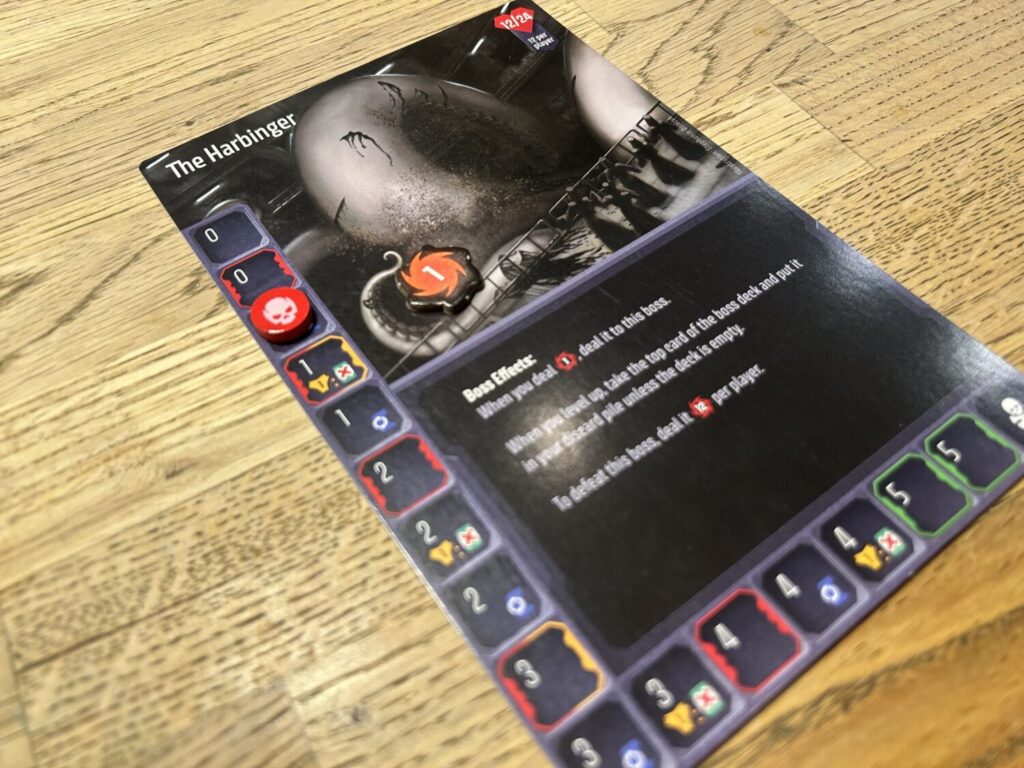
Smash the Button
It’s worth emphasizing that Unstoppable is challenging. I have now played around 15 games in total, and I still haven’t quite managed to eke out a victory on the hardest setting. While the game is certainly swingy, and a bad layout of Threats can end things for you before your time, it also rewards skill. Turns are a joy, perfectly walking a precarious line between having just enough information to make satisfying strategic and tactical choices while also allowing things to unfold in such a way that turns regularly have surprises, both for good and for ill. Much of the design ethos in Unstoppable seems centered around creating jams for you to wriggle your way out of. It’s a joy to do so.
Don’t buy this game if you hate sleeving. You’re gonna do it a lot. You’re also going to unsleeve a lot, since every Upgrade and every card has to be separated before putting the game away. That is an unavoidably tedious task, but Renegade Games has done everything they can to mollify it. The cards are designed so that Upgrades have tabs at the top, making them easier to remove. You will inevitably split all of the included sleeves, but there’s not much to be done about that, and mine have held up well through repeated plays. The provided box dividers are excellent, and allow for as quick a setup as it’s possible to have with a game like this. There’s also clearly plenty of room for expansions in this box, and I personally cannot wait to press that dopamine button again.
And again.
And again.
